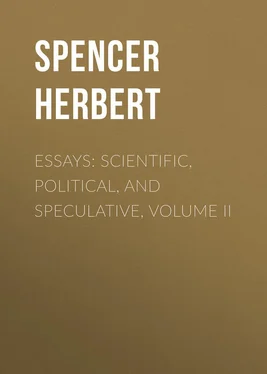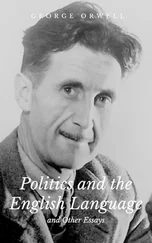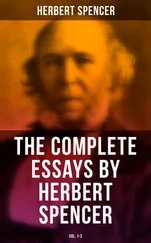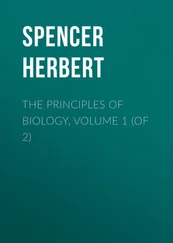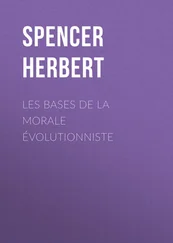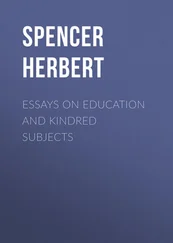Herbert Spencer - Essays - Scientific, Political, and Speculative, Volume II
Здесь есть возможность читать онлайн «Herbert Spencer - Essays - Scientific, Political, and Speculative, Volume II» — ознакомительный отрывок электронной книги совершенно бесплатно, а после прочтения отрывка купить полную версию. В некоторых случаях можно слушать аудио, скачать через торрент в формате fb2 и присутствует краткое содержание. Жанр: Философия, foreign_antique, foreign_prose, sketch, на английском языке. Описание произведения, (предисловие) а так же отзывы посетителей доступны на портале библиотеки ЛибКат.
- Название:Essays: Scientific, Political, and Speculative, Volume II
- Автор:
- Жанр:
- Год:неизвестен
- ISBN:нет данных
- Рейтинг книги:5 / 5. Голосов: 1
-
Избранное:Добавить в избранное
- Отзывы:
-
Ваша оценка:
- 100
- 1
- 2
- 3
- 4
- 5
Essays: Scientific, Political, and Speculative, Volume II: краткое содержание, описание и аннотация
Предлагаем к чтению аннотацию, описание, краткое содержание или предисловие (зависит от того, что написал сам автор книги «Essays: Scientific, Political, and Speculative, Volume II»). Если вы не нашли необходимую информацию о книге — напишите в комментариях, мы постараемся отыскать её.
Essays: Scientific, Political, and Speculative, Volume II — читать онлайн ознакомительный отрывок
Ниже представлен текст книги, разбитый по страницам. Система сохранения места последней прочитанной страницы, позволяет с удобством читать онлайн бесплатно книгу «Essays: Scientific, Political, and Speculative, Volume II», без необходимости каждый раз заново искать на чём Вы остановились. Поставьте закладку, и сможете в любой момент перейти на страницу, на которой закончили чтение.
Интервал:
Закладка:
And here it becomes manifest that not only is classification carried on by grouping together in the mind things that are like ; but that classes and sub-classes are formed and arranged according to the degrees of unlikeness . Things strongly contrasted are alone distinguished in the lower stages of mental evolution; as may be any day observed in an infant. And gradually as the powers of discrimination increase, the strongly-contrasted classes at first distinguished, come to be each divided into sub-classes, differing from each other less than the classes differ; and these sub-classes are again divided after the same manner. By the continuance of which process, things are gradually arranged into groups, the members of which are less and less unlike ; ending, finally, in groups whose members differ only as individuals, and not specifically. And thus there tends ultimately to arise the notion of complete likeness . For manifestly, it is impossible that groups should continue to be subdivided in virtue of smaller and smaller differences, without there being a simultaneous approximation to the notion of no difference .
Let us next notice that the recognition of likeness and unlikeness, which underlies classification, and out of which continued classification evolves the idea of complete likeness – let us next notice that it also underlies the process of naming , and by consequence language . For all language consists, at the outset, of symbols which are as like to the things symbolized as it is practicable to make them. The language of signs is a means of conveying ideas by mimicking the actions or peculiarities of the things referred to. Verbal language also, in its first stage, is a mode of suggesting objects or acts by imitating the sounds which the objects make, or with which the acts are accompanied. Originally these two languages were used simultaneously. It needs but to watch the gesticulations with which the savage accompanies his speech – to see a Bushman dramatizing before an audience his mode of catching game – or to note the extreme paucity of words in primitive vocabularies; to infer that in the beginning, attitudes, gestures, and sounds, were all combined to produce as good a likeness as possible of the things, animals, persons, or events described; and that as the sounds came to be understood by themselves the gestures fell into disuse: leaving traces, however, in the manners of the more excitable civilized races. But be this as it may, it suffices simply to observe, how many of the words current among barbarous peoples are like the sounds appertaining to the things signified; how many of our own oldest and simplest words have the same peculiarity; how children habitually invent imitative words; and how the sign-language spontaneously formed by deaf mutes is based on imitative actions – to be convinced that the notion of likeness is that from which the nomenclature of objects takes its rise. Were there space we might go on to point out how this law of likeness is traceable, not only in the origin but in the development of language; how in primitive tongues the plural is made by a duplication of the singular, which is a multiplication of the word to make it like the multiplicity of the things; how the use of metaphor – that prolific source of new words – is a suggesting of ideas which are like the ideas to be conveyed in some respect or other; and how, in the copious use of simile, fable, and allegory among uncivilized races, we see that complex conceptions which there is no direct language for, are rendered, by presenting known conceptions more or less like them.
This view is confirmed, and the predominance of this notion of likeness in primitive thought further illustrated, by the fact that our system of presenting ideas to the eye originated after the same fashion. Writing and printing have descended from picture-language. The earliest mode of permanently registering a fact was by depicting it on a skin and afterwards on a wall; that is – by exhibiting something as like to the thing to be remembered as it could be made. Gradually as the practice grew habitual and extensive, the most frequently repeated forms became fixed, and presently abbreviated; and, passing through the hieroglyphic and ideographic phases, the symbols lost all apparent relation to the things signified: just as the majority of our spoken words have done.
Observe, again, that the same thing is true respecting the genesis of reasoning. The likeness which is perceived to exist between cases, is the essence of all early reasoning and of much of our present reasoning. The savage, having by experience discovered a relation between a certain object and a certain act, infers that the like relation will be found in future. And the expressions we use in our arguments – “ analogy implies,” “the cases are not parallel ,” “by parity of reasoning,” “there is no similarity ,” – show how constantly the idea of likeness underlies our ratiocinative processes. Still more clearly will this be seen on recognizing the fact that there is a close connexion between reasoning and classification; that the two have a common root; and that neither can go on without the other. For on the one hand, it is a familiar truth that the attributing to a body in consequence of some of its properties, all those other properties in virtue of which it is referred to a particular class, is an act of inference. And, on the other hand, the forming of a generalization is the putting together in one class, all those cases which present like relations; while the drawing a deduction is essentially the perception that a particular case belongs to a certain class of cases previously generalized. So that as classification is a grouping together of like things ; reasoning is a grouping together of like relations among things. Add to which, that while the perfection gradually achieved in classification consists in the formation of groups of objects which are completely alike ; the perfection gradually achieved in reasoning consists in the formation of groups of cases which are completely alike .
Once more we may contemplate this dominant idea of likeness as exhibited in art. All art, civilized as well as savage, consists almost wholly in the making of objects like other objects; either as found in Nature, or as produced by previous art. If we trace back the varied art-products now existing, we find that at each stage the divergence from previous patterns is but small when compared with the agreement; and in the earliest art the persistency of imitation is yet more conspicuous. The old forms and ornaments and symbols were held sacred, and perpetually copied. Indeed, the strong imitative tendency notoriously displayed by the lowest human races – often seeming to be half automatic, ensures among them a constant reproducing of likenesses of things, forms, signs, sounds, actions and whatever else is imitable; and we may even suspect that this aboriginal peculiarity is in some way connected with the culture and development of this general conception, which we have found so deep and wide-spread in its applications.
And now let us go on to consider how, by a further unfolding of this same fundamental notion, there is a gradual formation of the first germs of science. This idea of likeness which underlies classification, nomenclature, language spoken and written, reasoning, and art; and which plays so important a part because all acts of intelligence are made possible only by distinguishing among surrounding things, or grouping them into like and unlike; – this idea we shall find to be the one of which science is the especial product. Already during the stage we have been describing, there has existed qualitative prevision in respect to the commoner phenomena with which savage life is familiar; and we have now to inquire how the elements of quantitative prevision are evolved. We shall find that they originate by the perfecting of this same idea of likeness – that they have their rise in that conception of complete likeness which, as we have seen, necessarily results from the continued process of classification.
Читать дальшеИнтервал:
Закладка:
Похожие книги на «Essays: Scientific, Political, and Speculative, Volume II»
Представляем Вашему вниманию похожие книги на «Essays: Scientific, Political, and Speculative, Volume II» списком для выбора. Мы отобрали схожую по названию и смыслу литературу в надежде предоставить читателям больше вариантов отыскать новые, интересные, ещё непрочитанные произведения.
Обсуждение, отзывы о книге «Essays: Scientific, Political, and Speculative, Volume II» и просто собственные мнения читателей. Оставьте ваши комментарии, напишите, что Вы думаете о произведении, его смысле или главных героях. Укажите что конкретно понравилось, а что нет, и почему Вы так считаете.
